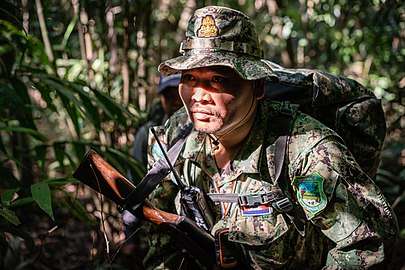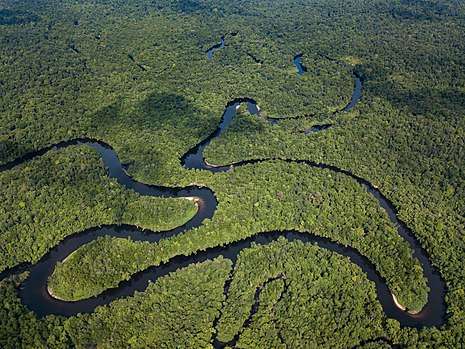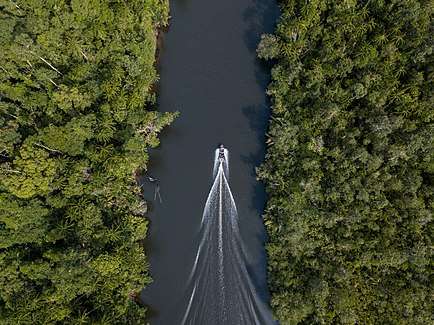Wildlife Alliance
Wildlife Alliance is an international non-profit wildlife and forest conservation organization with current programs and partnerships in Cambodia. It is headquartered in New York City, with offices in Phnom Penh. The logo of the organization is the Asian elephant, an emblematic species of Southeast Asia and the namesake for the organization's programs in the Southwest Elephant Corridor of the Cardamom Mountains of Cambodia. Suwanna Gauntlett is the Founder and CEO of Wildlife Alliance and one of the original founders of WildAid.[1][2] The organization is governed by a Board of Directors, and a International Advisory Board provides guidance on strategy, fundraising, and outreach.
 | |
| Motto | Direct Protection to Forests and Wildlife |
|---|---|
| Founded | 1995 |
| Founder | Suwanna Gauntlett |
| Type | 501(c)(3) |
| Focus | Forest and Wildlife Conservation |
| Location |
|
Area served | Cambodia |
| Method | train and equip park rangers to fight crimes against nature, improve the management of protected areas, support sustainable development initiatives, empower countries to enforce transboundary wildlife regulations |
Key people | Suwanna Gauntlett, founder and Chief Executive Officer Nick Marx, Director of Wildlife Rescue and Care |
Revenue | $4,469,627 (2011) |
| Website | https://www.wildlifealliance.org |
History and background
Wildlife Alliance was founded in 1995 by a group of American and British conservationists under the name Global Survival Network, and reorganized in 1999 as WildAid. The organization restructured itself again in 2006, dividing the organization's programs between two organizations - a new separate WildAid conducting the Active Conservation Awareness Program, Shark Conservation, and Galapagos Islands programs and Wildlife Alliance conducting field operations in Southeast Asia and Russia.
Programs
Wildlife Alliance's major ongoing programs are:

Cardamom Forest Protection Program - Wildlife Alliance rangers patrol 1,400,000 hectares of the Cardamom Rainforest Landscape in partnership with the Royal Government of Cambodia, making the Cardamom Mountains the best protected rainforest in Southeast Asia.[3][4] Ten rangers stations are manned with 14 rangers; 4 Ministry of Environment rangers, 8 Royal Gendarmerie of Cambodia Military Police, and 2 Wildlife Alliance Rangers. The rangers conduct daily patrols stopping land grabbing, dismantling illegal logger and poachers camps, seizing illegal timber and vehicles, removing snares, and releasing wildlife back into the wild. Before the program started, 38 elephants and 29 tigers had been killed.[5] Thanks to successful ranger patrolling, there has been zero elephant poaching in the Cardamoms since 2006.[6][7]
Zoning and Demarcation - Wildlife Alliance facilitates clear delineation of strictly protected forest zones versus community land where farmers can develop agriculture. The combination of a participatory planning process and the installation of visible posts on the ground has greatly helped in reducing land grabbing and deforestation.

Care for Rescued Wildlife - Since 2001, Wildlife Alliance's Care for Rescued Wildlife program has ensured that all rescued wildlife unfit for immediate release is given expert treatment, natural enclosures, a healthy diet, and trained veterinary care for as long as necessary. Working at Phnom Tamao Wildlife Rescue Centre, the staff have built large natural enclosures and designed excellent care protocols for the now 1,500 animals in their care. Wildlife Alliance has also created a Wildlife Rehabilitation Station in Koh Kong Province where animals that are deemed suitable for release into the wild are relocated to a forested enclosure in an appropriate area of habitat. Utilizing a soft release method, when the animals are ready for release, the door to the enclosure is left open and the animals are free to leave at will. Wildlife Alliance continue to provide hands-off assistance and supplementary food at the enclosure location for as long as it is necessary. In 2013, Wildlife Alliance established its Angkor Wildlife Release Program in cooperation with Apsara Authority and the Forestry Administration by releasing a pair of captive born Endangered pileated gibbons into the forest surrounding the iconic Angkor Wat Temple Complex in Siem Reap.[8][9][10]
Wildlife Rapid Rescue Team (WRRT) - A law enforcement unit devoted solely to combating the illegal wildlife trade, composed of Cambodian Forestry Administration officials and Royal Gendarmerie of Cambodia Military Police with technical and financial support from Wildlife Alliance. The team has a national mandate to stop the illegal wildlife trade on roads, in markets and restaurants, and along the border. As of 2020, the Wildlife Rapid Rescue Team has rescued more than 77,000 live animals, arrested almost 3500 traffickers, and confiscated large quantities of animal parts and other contraband.[11] As a result, the work of WRRT has gained recognition as one of Asia's foremost wildlife law enforcement units, receiving the ''Best Wildlife Law Enforcement Unit in Asia Award'' from the United Nations Environment Programme in 2015.[12][13] WRRT also cracks down on the transnational illegal wildlife trade, with Cambodia being used as a transit country for wildlife products heading onto Vietnam and China.[14] In 2018, WRRT was involved in the seize of a shipment of 3.4 tons of ivory originating from the Mozambique port of Nacala.[15] In 2020, in response to the COVID-19 outbreak and its links to the wildlife trade[16], Wildlife Alliance launched the #StopEatingWildlife campaign to fight the supply, demand, and consumption of wildlife meat by making Cambodian consumers more aware of the health risks of eating wildlife and how the trade supports the brutal snaring crisis of Cambodia’s wildlife.[17]
Community Agriculture Development Project - The Community Agriculture Development Project in Sovanna Baitong focuses on improving the livelihoods of 220 families who were previously destroying the rainforest through slash-and-burn cultivation and hunting wildlife. With the technical assistance of Wildlife Alliance, villagers have created and manage a Community Agriculture Association that oversees agriculture production, marketing of goods, health care, education, natural resource conservation, a savings program, a micro-credit system. More than 85% of the families now earn well above the initial goal of $40 per month.

Community Based Ecotourism - Wildlife Alliance has established Community-Based Ecotourism (CBET) projects in both Chi Pha t and Steung Areng. Wildlife Alliance provides technical assistance in facilitating the community’s design and planning process, deciding on roles and responsibilities of management committee and service groups, agreeing on decision-making procedures, how income will be allocated, and so on.[18] Families have stopped 100% forest slash-and-burn practices and are now earning sustainable income from international tourism.[19] Visitors come from all over the world to go on treks in the Cardamom rainforest, enjoy river kayaking or mountain biking, and stay at community guesthouses. Due to its success, the well-established Chi Phat CBET has won multiple international awards, including the Dubai International Award for Best Practices to Improve the Living Environment in 2014.[20]
Kouprey Express - In the early 2000s, Wildlife Alliance launched a national awareness campaign to address the lack of effective environmental education in Cambodia, to raise awareness among communities living in and near protected areas, and to provide guidance on how to live sustainably while protecting natural resources. In 2005, this campaign became the Kouprey Express Mobile Environmental Education Project (KE), which is still the only mobile environmental education project in Cambodia today. The comprehensive on-the-ground approach of the KE works with students and teachers of all ages and education levels in government and private schools and NGOs, as well as whole communities, to build capacities and understanding of environmental issues and influence positive behaviors, attitudes, and actions toward wildlife and their habitat. Consisting of a school-based curriculum that builds capacities of both students and teachers, a national awareness campaign, and whole community engagement, the KE highlights the many factors which threaten elephants and other wildlife: habitat loss, degradation and fragmentation, poaching, and wildlife trade. The program also incorporates larger themes that impact all wildlife and humans acutely: climate change and adaptation, water quality, waste management and recycling, sustainable livelihoods, biodiversity, and wildlife laws in Cambodia and eastern Thailand. Human-elephant conflict is a primary focus of our activities, particularly in the Cambodian-Thai border areas as elephants and other wildlife continually cross borders. The project is named after the Kouprey (Bos sauveli), a species of ox believed to be extinct in the wild.
Affiliations
Wildlife Alliance is partnered with the FREELAND Foundation and the Russian Phoenix Fund. Wildlife Alliance is also a member of the International Union for the Conservation of Nature, the Association of Southeast Asian Nations Wildlife Enforcement Network, Global Sustainable Tourism Council, Wildlife Conservation Network and the International Union for Conservation of Nature. The organization has conducted fieldwork in Asia in cooperation with Fauna and Flora International, Conservation International, Traffic (conservation programme), and other international conservation organizations. In 2009, Fauna and Flora International and Wildlife Alliance famously conducted an operation that destroyed 18 safrole oil factories in the remote Cardamom Mountains[21], a key ingredient in the production of MDMA.[22] A single raid in June 2009 destroyed enough oil to produce 44 million ecstasy tablets, causing a disruption of supplies to the UK market.[23]
Significant landmarks

- 1994 - Founding of Global Survival Network
- 1997 - Global Survival Network partners with Russian conservationists to launch the Phoenix Fund, a Vladivostok-based non-profit dedicated to protecting the Amur leopard, Siberian tiger, and their habitat and ecology
- 2000 - Launch of Care for Rescued Wildlife program at Phnom Tamao Wildlife Rescue Centre, to provide veterinary treatment, rehabilitation and lifetime care for animals rescued from the illegal wildlife trade.
- 2000: The Cambodian Forestry Administration and Wildlife Alliance confiscate 7 tigers in a STING operation.
- 2002: Establishment of the Southern Cardamom Forest Protection Program.
- 2002 - Cambodia program creates "Wilderness Protection Mobile Unit" – now known as the Wildlife Rapid Rescue Team (WRRT) – to stop the sale, purchase, and trade of illegally sourced wildlife and wildlife products.
- 2004 - Government of Thailand calls for regional wildlife law enforcement network to address Southeast Asia's role as a shipment hub for illegal wildlife products. Ultimate result is the creation of the ASEAN Wildlife Enforcement Network, of which Wildlife Alliance led the NGO support program from 2005 to 2008.
- 2005 - Initial assessment of wildlife and habitat threats in Gunung Leuser National Park, Indonesia. When the Boxing Day tsunami devastates the region weeks later, WildAid returns to conduct a post-tsunami assessment to help Indonesian government agencies respond to the crisis.
- 2006 - Phoenix Fund Director, Sergei Beruznuk, wins a £30,000 Whitley Award recognizing his "outstanding achievements in nature conservation" related to re-routing an oil pipeline away from the habitat of critically endangered Amur leopard.
- 2007 - Original WildAid changes name to Wildlife Alliance. CNN's Anderson Cooper 360° series, Planet in Peril, features Wildlife Alliance programs in Thailand and Cambodia, including Care for Rescued Wildlife, Bokor National Park, and efforts to stop the illegal wildlife trade in Asia.
- 2008 - Wildlife Alliance launches Community-Based Ecotourism program in the village commune of Chi Phat, Cambodia.
- 2008 - Launches reforestation project to reconnect the fragmented rainforest in the Cardamom Mountains.
- 2009 - MSNBC and Jeff Corwin visit Cambodia to film Wildlife Alliance field projects for the 100 Heartbeats documentary
- 2009 - Wildlife Alliance initiates the Southern Cardamom REDD+ Project in conjunction with the Royal Government of Cambodia’s Forestry Administration,
- 2010 - The Wildlife Rapid Rescue Team gains official recognition from ten Asian countries as Cambodia’s national level wildlife crime task force, when the Cambodian Forestry Administration actively implements the Association of South East Asian Nations Wildlife Enforcement Network (ASEAN-WEN) in Cambodia.
- 2011 - Cambodian government reverses plan to construct titanium mine in Cardamom Mountains, in light of online petitions and advocacy led by Wildlife Alliance
- 2012 - Wildlife Alliance releases their iPhone app created in collaboration with TRAFFIC, and Jeff Corwin Connect to allow users learn more about Cambodia's endangered wildlife and help the Wildlife Rapid Rescue Team stop the wildlife trade
- 2013 - Wildlife Alliance begins their Wildlife Anti-Trafficking Campaign in Cambodian Airports
- 2016 - A landscape Wildlife Alliance works to protect was recognised as a national park by the Cambodian government - The Southern Cardamom National Park.
- 2017 - Wildlife Alliance launches Community-Based Ecotourism program in the village of Chhay Areng (Steung Areng), Cambodia.
- 2017: WRRT seizes 3 tonnes of Ivory from Mozambique,
- 2019: PTWRC Team provide funds for a 16-man community patrol team working to protect the endangered Banteng in Phnom Chongreak.
- 2020: 1.4 million hectares of the Cardamom Mountains remains protected.
External links
- Wildlife Alliance - Home page
- Charity Navigator - Evaluation by America's premier independent charity evaluator
- Wall Street Journal - "A Fresh Start: Asian villages carve out a new life
- The Guardian (UK) - "Conservationists hope to avoid teenage kicks over elephant's false leg"
- Mongabay.com - "Cambodian prime minister cancels titanium mine project citing impact on biodiversity and local people"
- The Boston Globe - "In Cambodia's remote southwest, a village revived through tourism"
- The Washington Post - "Cambodia's Cardamom Mountains, full of secrets"
- Forbes - "Why the ivory problem requires dealing with supply not demand"
- Times Live - "Two sun bears rescued from Cambodian factory'
- Al Jazeera "Plundering Cambodia's Forests"
- Forbes ''Asia's 2018 Heroes Of Philanthropy: Putting Wealth To A Good Cause''
References
- "Suwanna Gauntlett - Founder and CEO Wildlife Alliance". www.wildlifealliance.org. Retrieved 2018-08-13.
- "Asia's 2018 Heroes Of Philanthropy: Putting Wealth To A Good Cause". www.forbes.com.
- "Plundering Cambodia's Forests". www.aljazeera.com.
- "Cardamom Forest Protection Program". www.wildlifealliance.org.
- "A Decade of Zero Elephant Poaching in the Cardamom Rainforest Landscape, Cambodia" (PDF). www.asesg.org.
- "A Decade of Zero Elephant Poaching in the Cardamom Rainforest Landscape, Cambodia" (PDF). www.asesg.org.
- "Cardamom Forest Protection Program". www.wildlifealliance.org.
- "Angkor Wildlife Release Program". www.wildlifealliance.org.
- https://www.wildlifealliance.org/wildlife-care/
- "The Reintroduction of Captive-born Pileated Gibbons (Hylobates pileatus) into the Angkor Protected Forest, Siem Reap, Cambodia". www.researchgate.net.
- https://www.wildlifealliance.org/wildlife-police/
- "Wildlife Rapid Rescue Team (WRRT)".
- "Wildlife Alliance's Wildlife Rapid Rescue Team Named Winner of the United Nations' Asia Environmental Enforcement Award".
- "Major shipment of suspected lion bones opened".
- "Wildlife Alliance 2018 Annual Report" (PDF).
- "'Wet markets' likely launched the coronavirus. Here's what you need to know".
- "#StopEatingWildlife". Wildlife Alliance. 13 May 2020.
- "Livelihoods".
- "Livelihoods".
- "WILDLIFE ALLIANCE: COMMUNITY-BASED ECOTOURISM IN THE CARDAMOM MOUNTAIN RANGE, CAMBODIA".
- "Latest raid on 'Ecstasy Oil Factories' in Cambodia".
- "REGULATION (EC) No 273/2004 OF THE EUROPEAN PARLIAMENT AND OF THE COUNCIL of 11 February 2004 on drug precursors".
- "Ecstasy 'disappearing' from British clubs".